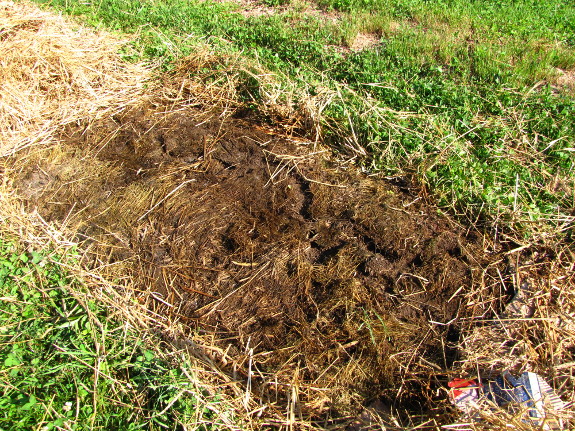
Taking apart a temporary kill mulch

A month ago, I laid
down a kill mulch over an annual ryegrass cover crop that I wanted to turn into
bare ground for this week's planting. The results were inspiring.
We've had very little
rain during that month, and even though I water most of the vegetable
garden, I've opted to leave this plot unirrigated in 2012. A
nearby bed that wasn't kill mulched is dry as a bone when I dug into
the top few inches, but the soil under my kill mulch had just the right
moisture content for planting.
 The photo at the top of this
post makes the kill-mulched soil look a little cloddy, but it's really
not. Instead, the dirt is held together with just enough fungal
bonds that it keeps its shape, but when I pulled the hoe through to
make a planting furrow, the earth split like the red sea.
The photo at the top of this
post makes the kill-mulched soil look a little cloddy, but it's really
not. Instead, the dirt is held together with just enough fungal
bonds that it keeps its shape, but when I pulled the hoe through to
make a planting furrow, the earth split like the red sea.
Under the kill mulch,
just about all of the ryegrass had died due to the absence of light,
leaving a thin layer of dead leaves on the soil surface. Lower
down, the roots had rotted and created a loose, crumbly soil totally
unlike what this awful area used to be like.
In case you're curious
about what to do with the cardboard and straw from a temporary kill
mulch like this --- it's all reusable. I raked back the straw,
carefully lifted the layers of cardboard off and transferred them to a
new plot of ground, then put the straw back on top. A few pieces
of cardboard tore, but the layer is just blocking grass and clover in
its new location, so I suspect it will do its job all over again.
(I wouldn't put secondhand kill mulch cardboard over serious weeds.)

The one potential
problem amid all this glory of kill mulching is small mammals.
Burrows of voles, moles, or shrews are obvious as soon as I lift up the
cardboard, and a few gardeners report these little guys harm their
crops. However, I've yet to see any damage from my furry kill
mulch neighbors, which makes me think my garden may only be home to the
insectivores (moles and shrews) rather than the herbivores
(voles). I'll let you know if I start seeing nibbled carrots and
potatoes.
Want more in-depth information? Browse through our books.
Or explore more posts by date or by subject.
About us: Anna Hess and Mark Hamilton spent over a decade living self-sufficiently in the mountains of Virginia before moving north to start over from scratch in the foothills of Ohio. They've experimented with permaculture, no-till gardening, trailersteading, home-based microbusinesses and much more, writing about their adventures in both blogs and books.
Want to be notified when new comments are posted on this page? Click on the RSS button after you add a comment to subscribe to the comment feed, or simply check the box beside "email replies to me" while writing your comment.
